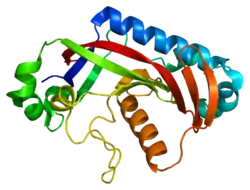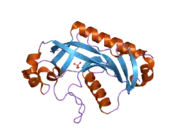2',3'-Cyclic-nucleotide 3'-phosphodiesterase
2′,3′-Cyclic-nucleotide 3'-phosphodiesterase (EC 3.1.4.37, CNPase, systematic name nucleoside-2′,3′-cyclic-phosphate 2′-nucleotidohydrolase) is an enzyme that in humans is encoded by the CNP gene.[5][6]
| 2′,3′-Cyclic-nucleotide 3'-phosphodiesterase | |||||||||
|---|---|---|---|---|---|---|---|---|---|
| Identifiers | |||||||||
| EC no. | 3.1.4.37 | ||||||||
| CAS no. | 60098-35-3 | ||||||||
| Databases | |||||||||
| IntEnz | IntEnz view | ||||||||
| BRENDA | BRENDA entry | ||||||||
| ExPASy | NiceZyme view | ||||||||
| KEGG | KEGG entry | ||||||||
| MetaCyc | metabolic pathway | ||||||||
| PRIAM | profile | ||||||||
| PDB structures | RCSB PDB PDBe PDBsum | ||||||||
| Gene Ontology | AmiGO / QuickGO | ||||||||
| |||||||||
Reaction
CNPase catalyzes the following reaction:
- nucleoside 2′,3′-cyclic phosphate + H2O nucleoside 2′-phosphate
Function
CNPase is a myelin-associated enzyme that makes up 4% of total CNS myelin protein, and is thought to undergo significant age-associated changes.[7] It is named for its ability to catalyze the phosphodiester hydrolysis of 2',3'-cyclic nucleotides to 2'-nucleotides, though a cohesive understanding of its specific physiologic functions are still ambiguous.[8]
Structural studies have revealed that four classes of CNPases belong to one protein superfamily. CNPase's catalytic core consists of three alpha-helices and nine beta-strands. The proposed mechanism of CNPases phosphodiesterase catalytic activity is similar to the second step of the reaction mechanism for RNase A.[9]
CNPase is expressed exclusively by oligodendrocytes in the CNS, and the appearance of CNPase seems to be one of the earliest events of oligodendrocyte differentiation.[10] CNPase is thought to play a critical role in the events leading up to myelination.[11]
CNPase also associates with microtubules in brain tissue and FRTL-5 thyroid cells, and is reported to have microtubule-associated protein-like activity (MAP; see MAP2), being able to catalyze microtubule formation at low molar ratios. Deletion of the C-terminus of CNPase or phosphorylation abolish the catalytic activity of microtubule formation. CNPase can link tubulin to cellular membranes, and might be involved in the regulation cytoplasmic microtubule distribution.[12]
CNPase has also been demonstrated to inhibit the replication of HIV-1 and other primate lentiviruses by binding the retroviral Gag protein and inhibiting the genesis of nascent viral particles. Whether this is a biological function of CNPase or a coincidental activity remains unclear.[13]
References
- GRCh38: Ensembl release 89: ENSG00000173786 - Ensembl, May 2017
- GRCm38: Ensembl release 89: ENSMUSG00000006782 - Ensembl, May 2017
- "Human PubMed Reference:". National Center for Biotechnology Information, U.S. National Library of Medicine.
- "Mouse PubMed Reference:". National Center for Biotechnology Information, U.S. National Library of Medicine.
- Sprinkle TJ, Lanclos KD, Lapp DF (Jul 1992). "Assignment of the human 2′,3′-cyclic nucleotide 3′-phosphohydrolase gene to chromosome 17". Genomics. 13 (3): 877–80. doi:10.1016/0888-7543(92)90174-Q. PMID 1322358.
- "Entrez Gene: CNP 2′,3′-cyclic nucleotide 3′-phosphodiesterase".
- Hinman JD, Chen CD, Oh SY, Hollander W, Abraham CR (Jan 2008). "Age-dependent accumulation of ubiquitinated 2',3'-cyclic nucleotide 3'-phosphodiesterase in myelin lipid rafts". Glia. 56 (1): 118–33. doi:10.1002/glia.20595. PMID 17963267. S2CID 8729201.
- Kursula P (Feb 2008). "Structural properties of proteins specific to the myelin sheath". Amino Acids. 34 (2): 175–85. doi:10.1007/s00726-006-0479-7. PMID 17177074. S2CID 20270722.
- Sakamoto Y, Tanaka N, Ichimiya T, Kurihara T, Nakamura KT (Feb 2005). "Crystal structure of the catalytic fragment of human brain 2',3'-cyclic-nucleotide 3'-phosphodiesterase". Journal of Molecular Biology. 346 (3): 789–800. doi:10.1016/j.jmb.2004.12.024. PMID 15713463.
- Kasama-Yoshida H, Tohyama Y, Kurihara T, Sakuma M, Kojima H, Tamai Y (Oct 1997). "A comparative study of 2',3'-cyclic-nucleotide 3'-phosphodiesterase in vertebrates: cDNA cloning and amino acid sequences for chicken and bullfrog enzymes". Journal of Neurochemistry. 69 (4): 1335–42. doi:10.1046/j.1471-4159.1997.69041335.x. PMID 9326261.
- Gravel M, Peterson J, Yong VW, Kottis V, Trapp B, Braun PE (Jun 1996). "Overexpression of 2',3'-cyclic nucleotide 3'-phosphodiesterase in transgenic mice alters oligodendrocyte development and produces aberrant myelination". Molecular and Cellular Neurosciences. 7 (6): 453–66. doi:10.1006/mcne.1996.0033. PMID 8875429. S2CID 35687881.
- Bifulco M, Laezza C, Stingo S, Wolff J (Feb 2002). "2',3'-Cyclic nucleotide 3'-phosphodiesterase: a membrane-bound, microtubule-associated protein and membrane anchor for tubulin". Proceedings of the National Academy of Sciences of the United States of America. 99 (4): 1807–12. Bibcode:2002PNAS...99.1807B. doi:10.1073/pnas.042678799. PMC 122275. PMID 11842207.
- Wilson SJ, Schoggins JW, Zang T, Kutluay SB, Jouvenet N, Alim MA, Bitzegeio J, Rice CM, Bieniasz PD (Oct 2012). "Inhibition of HIV-1 particle assembly by 2′,3′-cyclic-nucleotide 3′-phosphodiesterase". Cell Host & Microbe. 12 (4): 585–97. doi:10.1016/j.chom.2012.08.012. PMC 3498451. PMID 23084924.
External links
- Human CNP genome location and CNP gene details page in the UCSC Genome Browser.
Further reading
- Drummond GI, Iyer NT, Keith J (1962). "Hydrolysis of ribonucleoside 2',3'-cyclic phosphates by a diesterase from brain". J. Biol. Chem. 237 (11): 3535–3539. doi:10.1016/S0021-9258(19)70852-7.
- Helfman DM, Kuo JF (Jan 1982). "A homogeneous cyclic CMP phosphodiesterase hydrolyzes both pyrimidine and purine cyclic 2':3'- and 3':5'-nucleotides". The Journal of Biological Chemistry. 257 (2): 1044–7. doi:10.1016/S0021-9258(19)68305-5. PMID 6274851.
- Helfman DM, Shoji M, Kuo JF (Jun 1981). "Purification to homogeneity and general properties of a novel phosphodiesterase hydrolyzing cyclic CMP and cyclic AMP". The Journal of Biological Chemistry. 256 (12): 6327–34. doi:10.1016/S0021-9258(19)69166-0. PMID 6263914.
- Kurihara T, Nishizawa Y, Takahashi Y, Odani S (Apr 1981). "Chemical, immunological and catalytic properties of 2':3'-cyclic nucleotide 3'-phosphodiesterase purified from brain white matter". The Biochemical Journal. 195 (1): 153–7. doi:10.1042/bj1950153. PMC 1162865. PMID 6272743.
- Nishizawa Y, Kurihara T, Takahashi Y (Oct 1980). "Spectrophotometric assay, solubilization and purification of brain 2':3'-cyclic nucleotide 3'-phosphodiesterase". The Biochemical Journal. 191 (1): 71–82. doi:10.1042/bj1910071. PMC 1162183. PMID 6258586.
- Thompson RJ (Aug 1992). "2',3'-cyclic nucleotide-3'-phosphohydrolase and signal transduction in central nervous system myelin". Biochemical Society Transactions. 20 (3): 621–6. doi:10.1042/bst0200621. PMID 1385234.
- Leroy MJ, et al. (Apr 1992). "A new peptide (1150Da) selectively activates the calcium-calmodulin sensitive isoform of cyclic nucleotide phosphodiesterase from human myometrium". Biochemical and Biophysical Research Communications. 184 (2): 700–5. doi:10.1016/0006-291X(92)90646-3. PMID 1315529.
- Douglas AJ, et al. (Jul 1992). "Structure and chromosomal localization of the human 2',3'-cyclic nucleotide 3'-phosphodiesterase gene". Annals of Human Genetics. 56 (Pt 3): 243–54. doi:10.1111/j.1469-1809.1992.tb01149.x. PMID 1360194. S2CID 34627658.
- Staugaitis SM, Bernier L, Smith PR, Colman DR (Apr 1990). "Expression of the oligodendrocyte marker 2'3'-cyclic nucleotide 3'-phosphodiesterase in non-glial cells". Journal of Neuroscience Research. 25 (4): 556–60. doi:10.1002/jnr.490250413. PMID 2161933. S2CID 29416130.
- Agrawal HC, Sprinkle TJ, Agrawal D (Jul 1990). "2',3'-cyclic nucleotide-3'-phosphodiesterase in the central nervous system is fatty-acylated by thioester linkage". The Journal of Biological Chemistry. 265 (20): 11849–53. doi:10.1016/S0021-9258(19)38476-5. PMID 2164018.
- Kurihara T, Takahashi Y, Nishiyama A, Kumanishi T (Apr 1988). "cDNA cloning and amino acid sequence of human brain 2',3'-cyclic-nucleotide 3'-phosphodiesterase". Biochemical and Biophysical Research Communications. 152 (2): 837–42. doi:10.1016/S0006-291X(88)80114-1. PMID 2835044.
- Sprinkle TJ, McMorris FA, Yoshino J, DeVries GH (Jul 1985). "Differential expression of 2':3'-cyclic nucleotide 3'-phosphodiesterase in cultured central, peripheral, and extraneural cells". Neurochemical Research. 10 (7): 919–31. doi:10.1007/BF00964629. PMID 2995854. S2CID 34362955.
- Sheedlo HJ, Doran JE, Sprinkle TJ (Apr 1984). "An investigation of 2':3'-cyclic nucleotide 3'-phosphodiesterase (EC 3.1.4.37, CNP) in peripheral blood elements and CNS myelin". Life Sciences. 34 (18): 1731–7. doi:10.1016/0024-3205(84)90572-1. PMID 6328143.
- Monoh K, et al. (Jul 1993). "Structure, expression and chromosomal localization of the gene encoding human 2',3'-cyclic-nucleotide 3'-phosphodiesterase". Gene. 129 (2): 297–301. doi:10.1016/0378-1119(93)90283-9. PMID 8392017.
- Löbbert RW, Winterpacht A, Seipel B, Zabel BU (Oct 1996). "Molecular cloning and chromosomal assignment of the human homologue of the rat cGMP-inhibited phosphodiesterase 1 (PDE3A)--a gene involved in fat metabolism located at 11p 15.1". Genomics. 37 (2): 211–8. doi:10.1006/geno.1996.0544. PMID 8921398.
- Stricker R, Kalbacher H, Reiser G (Aug 1997). "The epitope recognized by a monoclonal antibody in the myelin-associated protein CNP". Biochemical and Biophysical Research Communications. 237 (2): 266–70. doi:10.1006/bbrc.1997.7125. PMID 9268698.
- O'Neill RC, Braun PE (Feb 2000). "Selective synthesis of 2',3'-cyclic nucleotide 3'-phosphodiesterase isoform 2 and identification of specifically phosphorylated serine residues". Journal of Neurochemistry. 74 (2): 540–6. doi:10.1046/j.1471-4159.2000.740540.x. PMID 10646504. S2CID 25697047.
- Zauli G, et al. (Feb 2001). "HIV-1 Tat protein down-regulates CREB transcription factor expression in PC12 neuronal cells through a phosphatidylinositol 3-kinase/AKT/cyclic nucleoside phosphodiesterase pathway". FASEB Journal. 15 (2): 483–91. doi:10.1096/fj.00-0354com. PMID 11156964. S2CID 26315564.
- Bifulco M, Laezza C, Stingo S, Wolff J (Feb 2002). "2',3'-Cyclic nucleotide 3'-phosphodiesterase: a membrane-bound, microtubule-associated protein and membrane anchor for tubulin". Proceedings of the National Academy of Sciences of the United States of America. 99 (4): 1807–12. Bibcode:2002PNAS...99.1807B. doi:10.1073/pnas.042678799. PMC 122275. PMID 11842207.
- Davidoff MS, et al. (2002). "Leydig cells of the human testis possess astrocyte and oligodendrocyte marker molecules". Acta Histochemica. 104 (1): 39–49. doi:10.1078/0065-1281-00630. PMID 11993850.
- Basrur V, et al. (2003). "Proteomic analysis of early melanosomes: identification of novel melanosomal proteins". Journal of Proteome Research. 2 (1): 69–79. doi:10.1021/pr025562r. PMID 12643545.
- Kozlov G, et al. (Nov 2003). "Structural evidence that brain cyclic nucleotide phosphodiesterase is a member of the 2H phosphodiesterase superfamily". The Journal of Biological Chemistry. 278 (46): 46021–8. doi:10.1074/jbc.M305176200. PMID 12947117.






